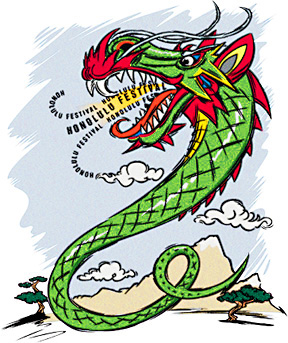 MAR. 11/12/13 |
 KIP AOKI / KAOKI@STARBULLETIN.COM |
Festival for all
to celebrate
THERE WILL BE A COUPLE of new things amidst the color and splendor of this year's Honolulu Festival, culminating in Sunday's Grand Parade down Waikiki's main thoroughfare. The theme, "A Journey Across the Pacific," will also include the debut of an Aboriginal dance troupe from Australia, who will perform among the many Japanese groups and couple of Hawaiian acts on stages located at the Hawai'i Convention Center, Ala Moana Center and the Royal Hawaiian Shopping Center.
The Honolulu Festival11th Annual Honolulu Festival: "A Journey Across the Pacific:"Where: Hawaii Convention Center, Ala Moana Center's Center Stage and the Royal Hawaiian Shopping Center When: 10 a.m. Saturday and Sunday (11 a.m. at the Royal Hawaiian Shopping Center) Admission: Free Info: www.honolulufestival.com Schedule » Saturday and Sunday at the convention center: Craft fair featuring more than 100 booths of Japanese and Hawaii artisans, and performances throughout both days, including Auntie Genoa Keawe (1:15-1:45 p.m. Saturday), members of the Descendance Aboriginal and Torres Strait Islander Dance Theatre from Australia (3:25-3:55 p.m. Saturday; also 10-10:30 a.m. at Ala Moana Center Stage, and 2:30-3 p.m. Sunday at the Royal Hawaiian Shopping Center), and Maunalua (1:10-1:40 p.m. Sunday). Japanese groups and competing hula halau from there will be mostly featured. Special events » 10 a.m. to 1 p.m. Saturday at the convention center, room 310: World premiere of the documentary "The Castaway: The Story of Manjiro," followed by a panel discussion (see story) » 4:30 to 8 p.m. Sunday: Grand Parade down Kalakaua Avenue, from Saratoga Boulevard to Kapiolani Park
|
Members of the Descendance Aboriginal and Torres Strait Islander Dance Theatre will make three appearances at the Honolulu Festival. Late last year, the company's small troupe took first prize in the dance category at the inaugural UNESCO World Culture Open in South Korea, one of 13 international groups that competed. (A permanent portion of the company regularly performs "Red Centre Dreaming" at the Red Centre Resort tourist spot in Alice Springs, Australia.)
Documentary filmmaker Ayumi Sato, in a phone interview from her Massachusetts home, said she "just finished a week ago my first professional film" about John Manjiro, whose remarkable journey began with his being shipwrecked in the Pacific Ocean.
After making it to a remote island's shore, the then-teenage Manjiro and his castaway companions were rescued by an American whaling ship from New Bedford, Mass. When they disembarked in Oahu, Manjiro chose to continue on to the ship's Massachusetts port.
Ten years later in 1851, with a formal Yankee education and experience as a whaler crewmember (stopping off in Oahu again) behind him, Manjiro, with two of the four castaways on Oahu, would return to his homeland.
As he became reacquainted with his home language and culture, with the arrival of Commodore Perry's flotilla in 1853, the Tokugawa Shogunate utilized Manjiro's adopted Yankee upbringing for help in learning about this alien U.S. presence. Manjiro was elevated to samurai status, in direct service to the shogunate.

Sunday's festivities will include beautiful floats through the streets of Waikiki...
"It was almost by accident that I started work on 'Castaway,'" she said. Through her work at Boston public television station WGBH with an independent producer on the "Frontline" series, she ran across Manjiro's name during an online search, finding out that he earned a small fortune in the gold mines in an area of the Sierra Nevada mountains. (It was money enough to help spur him to go to Oahu to try to pick up his former shipmates and return to Japan.)
Once again acting as a trailblazer, Sato said Manjiro was "the only Japanese to go to California to get gold."
"Manjiro was very smart. At first, he didn't have access to education in Japan because he was just a fisherman. His family was very poor and his father died when he was very young. But he learned a basic knowledge and how to live and out of necessity. ... He got where he did through his natural personality. He was very eager to learn, and seems to have been a very loving person. That's why he was accepted by many people, because he was so outgoing."

...as well as dancers.
Sato said she did interviews both in the United States and Japan, including a member of the Joseph Heco Society of Hawaii. (Heco was also a castaway, and lived on the West Coast in the 1850s.) She spoke with both researchers and descendants for her documentary, "plus I used a lot of archive photos and paintings, and also used his own letters."
Following the screening of "The Castaway," descendants of Manjiro; William Whitfield, the captain of the rescuing whaler; and the Rev. Samuel Chenery Damon, who helped Manjiro return to Japan, will be presented. Mrs. Kyo Nakahama of Japan, Robert Whitfield of Maryland, and Dwight Damon of Honolulu will speak after the 46-minute documentary.
Even though "The Castaway" was first screened at a private gathering of the Japan Society of Connecticut last week, it gets its world premiere public showing Saturday as part of the Honolulu Festival.
"It took two years and four months to do this film," Sato said. "The hardest part was fund-raising, but it's pretty much self-financed, thanks to my engineer husband."

The Descendance Aboriginal (above) and Torres Strait Islander Dance Theatre (below) from Australia will perform Saturday at the Hawaii Convention Center.

[News] [Business] [Features] [Sports] [Editorial] [Do It Electric!]
[Classified Ads] [Search] [Subscribe] [Info] [Letter to Editor]
[Feedback]
